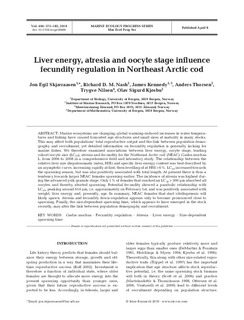Liver energy, atresia and oocyte stage influence fecundity regulation in Northeast Arctic cod
Skjæraasen, Jon Egil; Nash, Richard D.M.; Kennedy, James; Thorsen, Anders; Nilsen, Trygve; Kjesbu, Olav Sigurd
Journal article, Peer reviewed
Permanent lenke
http://hdl.handle.net/11250/108792Utgivelsesdato
2010-04-08Metadata
Vis full innførselSamlinger
- Articles [3012]
Originalversjon
http://dx.doi.org/10.3354/meps08486Sammendrag
Marine ecosystems are changing; global warming-induced increases in water temperatures and fishing have caused truncated age structures and small sizes at maturity in many stocks. This may affect both populations’ total reproductive output and the link between population demography and recruitment, yet detailed information on fecundity regulation is generally lacking for marine fishes. We therefore examined associations between liver energy, oocyte stage, leading cohort oocyte size (LC20), atresia and fecundity for the Northeast Arctic cod (NEAC) Gadus morhua L. from 2006 to 2008 in a comprehensive field and laboratory study. The relationship between the relative liver size (hepatosomatic index, HSI) and specific liver energy content was best described by an asymptotic curve, increasing rapidly at first, then levelling of at HSI > 6%. LC20 increased towards the spawning season, but was also positively associated with total length. At present there is thus a tendency towards larger NEAC females spawning earlier. The incidence of atresia was highest during the advanced yolk granule stage. Only 1% of females that reached an LC20 > 300 µm absorbed all oocytes and thereby aborted spawning. Potential fecundity showed a parabolic relationship with LC20, peaking around 614 µm, i.e. approximately on February 1st, and was positively associated with weight, liver energy and, presently, age. In summary, NEAC females that start vitellogenesis will likely spawn. Atresia and fecundity down-regulation appears only to become pronounced close to spawning. Finally, the size-dependent spawning time, which appears to have emerged in the stock recently, may alter the link between population demography and recruitment.
